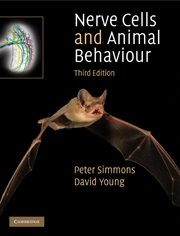Book contents
- Frontmatter
- Contents
- Preface
- 1 Organisation of animal behaviour and of brains: feeding in star-nosed moles and courtship in fruit flies
- 2 Signals in nerve cells: reflexes in mammals and insects
- 3 Neuronal mechanisms for releasing behaviour: predator and prey – toad and cockroach
- 4 Neuronal pathways for behaviour: startle behaviours and giant neurons in crayfish and fish
- 5 Eyes and vision: sensory filtering and course control in insects
- 6 Sensory maps: hunting by owls and bats
- 7 Programmes for movement: how nervous systems generate and control rhythmic movements
- 8 Changes in nerve cells and behaviour: learning in bees and rats; swarming in locusts
- 9 Nerve cells and animal signalling: songs of crickets, electric fish and birds
- References
- Index
- References
4 - Neuronal pathways for behaviour: startle behaviours and giant neurons in crayfish and fish
Published online by Cambridge University Press: 05 August 2012
- Frontmatter
- Contents
- Preface
- 1 Organisation of animal behaviour and of brains: feeding in star-nosed moles and courtship in fruit flies
- 2 Signals in nerve cells: reflexes in mammals and insects
- 3 Neuronal mechanisms for releasing behaviour: predator and prey – toad and cockroach
- 4 Neuronal pathways for behaviour: startle behaviours and giant neurons in crayfish and fish
- 5 Eyes and vision: sensory filtering and course control in insects
- 6 Sensory maps: hunting by owls and bats
- 7 Programmes for movement: how nervous systems generate and control rhythmic movements
- 8 Changes in nerve cells and behaviour: learning in bees and rats; swarming in locusts
- 9 Nerve cells and animal signalling: songs of crickets, electric fish and birds
- References
- Index
- References
Summary
When an animal is startled by a sudden attack from a predator, it must respond with great urgency if it is to escape, and neuronal pathways that initiate such an escape response must be both straightforward and reliable in order to fulfil their biological function. Straightforward pathways are essential to ensure speed in initiating the escape and they must be reliable not only to make sure the response occurs when needed but also to avoid false alarms. These qualities of simplicity and reliability, which are of great survival value to the animal, are also of service to the neuroethologist exploring the roles that nerve cells play in behaviour. Consequently, several startle responses have been studied in detail and they provide valuable insight into the flow of information through the nervous system from sensory inputs to muscular output.
As we have already shown in our description of cockroach escape behaviour in the previous chapter, the neuronal pathways responsible for startle responses often involve neurons that are exceptionally large and so are called giant neurons. The unusual width of the axon of a giant neuron enables it to conduct spikes rapidly along the animal's body. For an experimenter, the size of giant neurons also makes it relatively easy to insert microelectrodes into them, although because any small movements will dislodge an intracellular microelectrode, it is not possible to make intracellular recordings from neurons in freely moving animals.
- Type
- Chapter
- Information
- Nerve Cells and Animal Behaviour , pp. 60 - 89Publisher: Cambridge University PressPrint publication year: 2010



